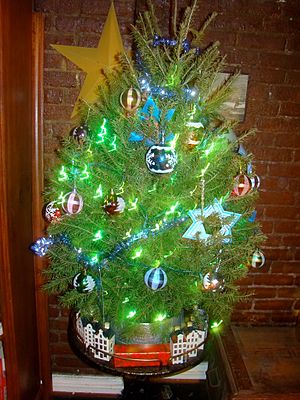Hanukkah bush facts for kids

A Hanukkah bush is a type of bush or tree. It can be a real plant or an artificial one. Some Jewish families in North America display these in their homes during the Hanukkah holiday. It often looks very similar to a Christmas tree but is decorated with Jewish-themed ornaments. This custom is sometimes linked to a mix of traditions called Chrismukkah.
Why Some Families Have a Hanukkah Bush
The idea of a Hanukkah bush can be a bit tricky for some people. Some Jewish families see it as a special way to celebrate Hanukkah. They might decorate it with symbols like a menorah or a Star of David. This makes it feel like a unique Jewish decoration.
However, other Jewish people worry that a Hanukkah bush looks too much like a Christmas tree. They are concerned that it might make Jewish families seem to be moving away from Jewish traditions and closer to Christian ones.
In North America, Hanukkah is often celebrated in ways that include some customs from Christmas. The Christmas tree is one of these customs. Not all Jewish people feel the same way about Christmas trees. Some might see them as a reminder of past difficulties between Christians and Jews.
Most rabbis today do not encourage Hanukkah bushes. However, some more open-minded rabbis, especially from the Reform, Reconstructionist, and liberal Conservative movements, do not object to them. For example, Rabbi Ron Isaacs wrote in 2003 that a Christmas tree has become a common symbol of the American Christmas holiday, not just a religious one. He felt that whether a family has one depends on their own choice and beliefs. Some Jewish families feel they can have a tree without celebrating the Christian parts of the holiday.
Today, the phrase "Hanukkah bush" is often used as a kind of in-joke. It's not always a serious custom, though many families still do it. It can be a funny thing to mention when non-Jewish people ask about holiday decorations. Other similar jokes among American Jews during Christmas include eating at a Chinese restaurant or attending "Matzah Ball" parties on Christmas Eve.
Stories About the Hanukkah Bush
The term Hanukkah bush has been around for a long time. In a newspaper from January 10, 1879, Henrietta Szold asked, "Why need we adopt the Christmas tree, ridiculously baptized a Chanukah bush?" This shows that the idea of a "Hanukkah bush" was already being discussed back then.
In 1959, actress Gertrude Berg appeared on The Ed Sullivan Show. She talked about how her father used a "Chanukah bush" instead of a Christmas tree.
Another story comes from Edward Cohen, who wrote about Jewish life in Mississippi in the 1950s. He recalled asking his mother for a Christmas tree. His mother refused at first. She explained that Hanukkah was a Jewish holiday, and they didn't celebrate Christmas. She finally agreed to let him have a tree in his room with the door closed. She didn't want a Christmas tree in her window. She felt that some Jewish parents who bought small Christmas trees and called them "Hanukkah bushes" were just pretending. These trees might have a Star of David on top and figures of Maccabees (Jewish warriors) mixed with a few Santas. To her, this was just a trick.
The phrase "Hanukkah bush" is usually not meant to be taken seriously. It's often a way of saying, "We have a decorated tree for the holiday season, but we are not celebrating Christmas." Peter W. Williams wrote that some Jewish people might add a "Hanukkah bush" with a bit of humor. They might even joke about visits from "Hanukkah Harry" or "Uncle Max, the Hanukkah man," who are like Jewish versions of Santa Claus.
It often sounds like a joking apology, especially to other Jewish people, for having a custom that is enjoyable but not quite traditional. For example, in one novel, a character named Louis was caught buying a Christmas tree. He tried to say it was a "Hanukkah bush." His friend then teased him about it.
Susan Sussman's 1983 children's book, There's No Such Thing as a Chanukah Bush, Sandy Goldstein, talks about the challenges Jewish families face in a society where Christmas is very popular. It also shows the differences between Jewish families who do and do not have holiday trees. In the story, a wise grandfather helps a child named Robin understand. The book suggests that sharing the Christmas holiday is okay, but observing it (as a religious holiday) is different. Robin realizes that maybe her friend needed a "Chanukah bush" because she didn't have friends who shared with her. A TV show based on this book won an Emmy award in 1998.
Even in popular culture, the idea of a "Chanukah bush" appears. In a novelty Christmas song, Wild Man Fischer sings "I'm a Chanukah Bush," surprising his duet partner. He then corrects himself, saying, "I'm a lot like... A JEWISH CHRISTMAS TREE!! WOW! But I'm not."
In December 1974, a Saks Fifth Avenue ad in The New York Times offered holiday items, including a "happy bagel" ornament. It was described as "ready to hang on a Christmas tree, Chanukah bush, or around your neck."
In 1981, there was a discussion about a Nativity scene in the South Dakota capitol. A Christmas tree there had been decorated with seventeen Stars of David. These stars were made by students from an Indian school. Governor Bill Janklow joked about contributing a "Hanukkah bush." The stars were later spread out among other Christmas trees to avoid making some Jewish people feel that the state was supporting Hanukkah bushes.
A Hanukkah bush would not have Christian decorations, like ornaments showing the Magi. However, most traditional U.S. Christmas tree ornaments, such as colored balls and tinsel, do not have strong Christian meanings. Some online stores even sell artificial Hanukkah bushes and Star of David tree toppers.
he:יחס יהודים לחג המולד#סינקרטיזm של חג המולד וחנוכה

